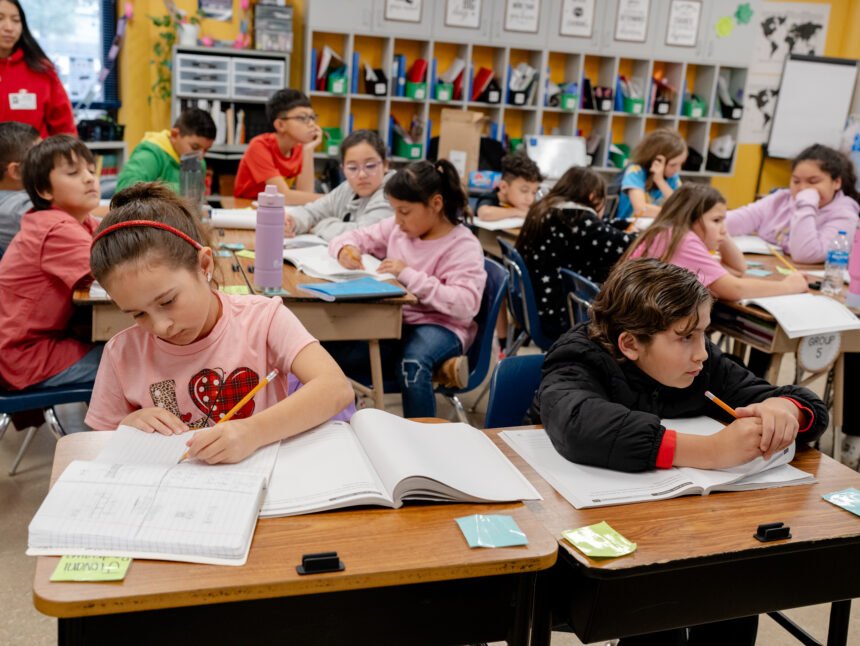Six San Antonio-area school districts will adopt some portion of new state-developed instructional materials in classes this fall, and several more may yet decide to use it, according to public records and spokespeople for the districts.
Last year, the Texas Education Agency released Bluebonnet Learning, a curriculum that covers kindergarten through 8th-grade math, including Algebra I, and a K-5 Reading Language Arts portion, which has been criticized for centering on Christianity and Bible lessons.
Of the handful of local districts that do plan to adopt the Bluebonnet Learning curriculum, which comes with additional funding for their students, most will only adopt the math portions.
Bluebonnet Learning was created to comply with House Bill 1605, which tasked the TEA with developing state-owned textbooks subject to approval by the State Board of Education and the Instructional Materials Review and Approval process.
SBOE approved the curriculum with an 8-7 vote in November.
Districts are still free to choose the curriculum their teachers use, but are incentivized to adopt the state-authored materials, and other curricula deemed by the state as “high-quality instructional materials,” with an additional $40 per student per year and an extra $20 per student per year that can be used for printing costs.
In a joint Jan. 30 letter, legal rights groups such as the ACLU and the Freedom from Religion Foundation urged superintendents and school board members around the state not to adopt the K-5 reading language arts portion of the curriculum because they claim Bluebonnet Learning is full of “Christian biblical references and lessons that amount to proselytizing.”
The letter also promised to monitor districts who adopt the optional curriculum and take legal action to “protect the rights of Texas children and their parents.”
In response to the letter’s claims, a TEA spokesperson told the Texas Tribune that public schools aren’t allowed to provide religious instruction.
During a recent event hosted by Texas Public Policy Foundation, a conservative think tank, State Board of Education member Julie Pickren said it doesn’t push Christianity on students.
“What it does, is it uses the Old Testament and the New Testament to provide a richness in education,” she said.
Districts make their choices
Meanwhile, local school districts are forging ahead with plans to adopt the new curriculum or not.
South San Independent School District approved the purchase of the TEA materials in January. After the meeting, Superintendent Henry Yzaguirre told the San Antonio Express-News the Bluebonnet Learning materials were recommended because of their potential to help teachers, “not because of the money attached.”
Which portions of the curriculum South San ISD will adopt is still unclear.
Spokesperson Alexis Lafosse said district leadership remain confident in their current curriculum and “will take a thorough approach in reviewing relevant materials from Bluebonnet Learning.”
The description for the K-5 Reading Language Arts curriculum says Bluebonnet Learning uses the science of reading, which is a phonics-based approach to reading instruction, and a classical education model focused on the fundamentals.
What is in the curriculum?
Pickren explained that a classical education model means students will receive instruction on cursive starting in the second grade and will be exposed to “great Western literature” such as Shakespeare.
Pickren, a Republican who represents District 7 on the board, which encompasses southeastern Texas, also noted Bluebonnet Learning lessons will only require pencil and paper instead of electronic devices, which puts teachers “back to the center of the classroom.”
And though the Bluebonnet Learning materials are free to access online, districts will have to pay if they want to print versions of the curriculum. One administrative textbook for kindergarten math, which provides teachers with lessons, assessments and a program and implementation guide, costs $933, according to the Bluebonnet Learning Instructional Materials pricing list.
As an example of the curriculum’s biblical references, Pickren pointed to the state’s Baby Moses Law, also known as the Safe Haven Law, which allows for parents who are unable to care for their newborns to drop them off at designated safe places with no questions asked.
“If you don’t know who baby Moses is, there’s no context for [the law],” Pickren said.
David R. Brochman is a religious studies scholar who was commissioned by the Texas Freedom Network — a statewide nonpartisan organization that promotes keeping religion out of public schools — to examine the Bluebonnet Learning curriculum’s religious references.
Brochman’s report found that the curriculum “overemphasizes” Christianity, subtly proselytizes students and works Bible lessons into the curriculum even when they are “unnecessary and unwarranted.”
In addition to the Christian influence, the materials understate negative events consequential to the early history of America, including the brutal treatment of Native Americans and the foundational role played by slavery, critics say.
“Through the use of mild terms such as ‘share,’ ‘introduce,’ and ‘teach,’ rather than the more accurate ‘attempt to convert,’ the authors misleadingly suggest that conversion efforts were a friendly dialogue between religions and consistently conceal the religious intolerance and often brutal power dynamics at play in these efforts,” Brockman wrote.
Districts’ reasoning
Many school districts that reported they won’t be using Bluebonnet Learning cited the quality of existing teaching materials.
Northside Independent School District, for example, one of the largest in the state, will continue to use its own, locally developed and TEKS-based curriculum “because it allows us, as a district to best meet the needs of our students,” district spokesperson Barry Perez said.
Medina Valley Independent School District, which includes parts of San Antonio’s West Side and the city of Castroville, will also continue to use its own teacher-developed curriculum.
“We are not looking to change what we are using, as we have been very successful with our current system,” Medina Valley ISD spokesperson Selena Viera said.













